|
|
|
Sort Order |
|
|
|
Items / Page
|
|
|
|
|
|
|
| Srl | Item |
| 1 |
ID:
130170


|
|
|
|
|
| Publication |
2014.
|
| Summary/Abstract |
Asia's middle powers face a trilateral dilemma stemming from their relationships with the U.S. and China. This paper uses the Australian example to examine the dilemma. It shows that Australia has bound itself to the U.S. because of domestic political factors, cost considerations, a belief that it can keep its interests separate, and its perception of regional threats. The paper then argues that others are likely to resolve their trilateral dilemmas in ways that make the regional strategic dynamic more competitive.
|
|
|
|
|
|
|
|
|
|
|
|
|
|
|
|
| 2 |
ID:
130176
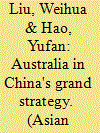

|
|
|
|
|
| Publication |
2014.
|
| Summary/Abstract |
This paper examines China's strategic interests in Australia. From the security per- spective, Beijing hopes that Australia will be a constructive factor for its peaceful rise. On the economic side, Beijing hopes that the bilateral relationship will ensure sufficient and sustainable resources and energy supplies from Australia for China's domestic needs
|
|
|
|
|
|
|
|
|
|
|
|
|
|
|
|
| 3 |
ID:
130174


|
|
|
|
|
| Publication |
2014.
|
| Summary/Abstract |
In responding to China's rise, the best strategy for Australia involves a combination of accommodation and ''soft balancing.'' The viability of this strategy is related to the extent to which U.S.-China relations are cooperative or conflictual. Recent Australian governments have been successful in implementing this preferred strategy.
|
|
|
|
|
|
|
|
|
|
|
|
|
|
|
|
| 4 |
ID:
130163
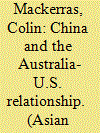

|
|
|
|
|
| Publication |
2014.
|
| Summary/Abstract |
This paper analyzes China's impact on Australia-U.S. relations from 1949 to 1996, including how far Australia's China policy followed the American lead. The conclusion: American influence was dominant, but Australia's own initiative was enough to belie the suggestion that it was no more than a blind follower.
|
|
|
|
|
|
|
|
|
|
|
|
|
|
|
|
| 5 |
ID:
130164
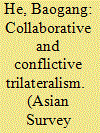

|
|
|
|
|
| Publication |
2014.
|
| Summary/Abstract |
This paper provides a critical overview of Australian, Chinese, and American perspectives on trilatesralim, with a detailed discussion of Australian debates on the matter. Its aim is to trace the evolution of the changing discourse on the rise of China, examine major debates in Australia, and provide both an intellectual background and an overview for this special issue.
|
|
|
|
|
|
|
|
|
|
|
|
|
|
|
|
| 6 |
ID:
130177
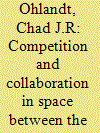

|
|
|
|
|
| Publication |
2014.
|
| Summary/Abstract |
U.S. national security space policy has recently shifted significantly toward increased international cooperation. Australian space activities have been reinvigorated, but remain underfunded. China's space activities remain vigorous, but largely unilateral. Given U.S. policy changes, opportunities for cooperation and collaboration among all three have improved.
|
|
|
|
|
|
|
|
|
|
|
|
|
|
|
|
| 7 |
ID:
130168
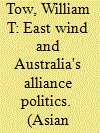

|
|
|
|
|
| Publication |
2014.
|
| Summary/Abstract |
Ongoing reassessments in U.S. strategy in the Asia-Pacific have coincided with a major growth in Sino-Australian economic relations. The Australian-American alliance could be increasingly tested if U.S. policy planners are unsuccessful in generating more sensitive and proactive alliance security postures to ensure Australian support for key U.S. interests in the Asia-Pacific
|
|
|
|
|
|
|
|
|
|
|
|
|
|
|
|
| 8 |
ID:
130162
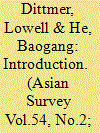

|
|
|
|
|
| Publication |
2014.
|
| Summary/Abstract |
IN THE PAST 20 YEARS, CHINA HAS RISEN to become the second largest economic power in the world. Its GDP surpassed that of Canada in 1993, Italy in 2000, France in 2005, the U.K. in 2006, Germany in 2008, and Japan in 2009. In 2012 it surpassed the United States as the world's largest trading nation (the U.S. remains the largest importer). China is now the number one trading partner of Australia, Japan, South Korea, and the ?rst or second trading partner of the 10 nations in the Association of Southeast Asian Nations (ASEAN), not counting the EU. Growing economic dependence upon China, however, raises long-term security issues for all Asian trade partners, given their strategic proximity to ambitious China. This is also true for Australia, just 200 kilometers from Indonesia at their closest points. Canberra, unable to shore up a security guarantee from Beijing, has increased its purchase in the security insurance policies of Washington.
|
|
|
|
|
|
|
|
|
|
|
|
|
|
|
|
| 9 |
ID:
130175
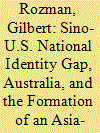

|
|
|
|
|
| Publication |
2014.
|
| Summary/Abstract |
Australia is a middle power caught between rising dependence on China, which seeks a sinocentric region, and growing security reliance on the U.S., which strives for a trans-Pacific community supporting universal values. In light of the Sino-U.S. identity gap and different concepts of regionalism, its response becomes clearer.
|
|
|
|
|
|
|
|
|
|
|
|
|
|
|
|
|
|
|
|
|